Blue Flash Music Trust


The Town Hall; community heritage
Page contents; Francis Maude re the Town Hall, the rebuilds of 1812 & 1888, the ghost, the place of the hall in the town, architectural changes, the acoustics, the community spaces both inside and out!
In the BBC documentary ‘VillageSOS’ (10 Aug 2011) re the rebuilding of the water mill in Talgarth, Wales, Sarah Beeny used the phrase ‘community heritage’, and, like the Talgarth Water Mill, the Horsham Town Hall has the potential to bring the
people of Horsham together as it has done in the past.
Press release – 5 April 2012
2012 Marks the 200th Anniversary of the First Rebuild of Horsham’s Old Town Hall in its present form.
2012 not only marks the 200th anniversary of the birth of Charles Dickens and the enclosure of Horsham Common, it also marks the anniversary of the rebuild of Horsham Town Hall in 1812. This work generated the unique design feature of the deliberately constructed solid arches; a feature that was designed to stop people looking in on proceedings of the magistrates’ court hearings; hearings of those such as John George Haigh, the infamous ‘acid bath murderer.’ In 2004 English Heritage described the solid frontage of the Town Hall as a "a deliberate construction to stop people looking in at court proceedings, and as a feature of the past should remain." This rebuild was a very significant step because for the first time, the entire building became a single unit for the exercise of government and legal proceedings. In the earlier buildings the lower part had provided cover for the fire engine as well as being the site of poultry and butter markets!
In 1812 a considerable step forward had also been made via the three grandiose coat of arms on the frontage, but as time would show, there was still little substance in the building itself. It had been rebuilt by the then Duke of Norfolk in an effort to retain some of the town’s political importance at a cost of £8,000. The cost however did not ensure quality workmanship for over the following years many of the effects of shoddy workmanship became apparent; judges were reluctant to visit the building because the roof was leaking so badly that they believed that one day the floor would give way and they would all tumble down into the chamber below.
By strange co-incidence, 2012 also marks the 200th anniversary of the birth of architect Augustus Pugin. Robert Mayfield, local author and Treasurer of local arts charity the Blue Flash Music Trust said:
“I feel that it was Pugin’s vision and influence that indirectly saved the Horsham Town Hall for future generations. Pugin felt that architecture should be honest, and what the building said on the outside, was also what it said on the inside. He despised lack of architectural honesty and attacked it in many of his writings. By the time of the rebuild of 1888 Augustus Pugin had been born, worked and died. However, Pugin’s influence did not end there for once the Old Town Hall had been handed over by the Duke of Norfolk in 1888 to the three Trustees of the Local Board of Health, one of whom was the local MP Robert Hurst, the building, other than the frontage of 1812 had undergone a further rebuild. Now the whole building gave out the same message; that it was a place of local government in tune with the retained front façade, displaying the Royal Coat of Arms, and the arms of the Horsham Borough and the Duke of Norfolk. The building was now giving out the same message in its entirety.”
In the prologue of her book ‘Pugin; God’s Architect,’ upon which a recent BBC4 television programme was based, Rosemary Hill, of the Victorian Society, wrote “The architectural texture of our towns and of the countryside is still largely nineteenth – century and none of it would look, quite, as it does had AWN Pugin not lived.”
Mr Mayfield added:
“Augustus Pugin was educated at Christ Hospital and became a very famous architect working on such grand houses as Albury Park Mansion near Leatherhead, and Horsted Place near Uckfield. He was also the architect of the Houses of Parliament and Big Ben after the earlier buildings were destroyed by fire in 1834. His preference for solid construction had a long lasting effect and can be seen in the confident and noble building that now stands in Market Square today. The rebuild was so sound that although one hundred and twenty four years has passed since, the building is as good as ever, and to quote the words of Dr Timothy Brittain-Caitlin, who contributed to the programme, “God could go round the back and be pleased.”
“Like other Horsham buildings such as St Marks Church, now the site of Royal and SunAlliance and the Capitol Theatre, now the site of Marks and Spencers, the Town Hall was rebuilt as a charitable act. The further rebuild must have cost a great sum of money compared with the cost of 1812, considering the extra amount of work that had to be done.”
The Blue Flash Music Trust has approached Rosemary Hill and the Pugin Society with the idea of holding a lecture on Pugin and his legacy.
Press release - 5 April 2012
Ghost of Dan Roberts to protect the Old Town Hall?
It seems some Old Town Hall campaigners are banking on the supernatural in the ghostly form of Dan Roberts to save the building for the community.
Robert Mayfield, treasurer of local arts charity the Blue Flash Music Trust and author of the forthcoming book 'Dan Roberts' Dream' said:
"Some people claim that they have seen the ghost of Dan Roberts with his distinctive frock coat, hat and cane floating near the stage on the ground floor of the Old Town Hall. Others believe his ghost will haunt all those that cross him over the building. It certainly seems true that many Horsham District Council officials and organisations involved with them over the Old Town Hall have suffered some misfortunes over the last five years. However, there may be alternative explanations for these happenings."
Dan Roberts was the Custodian of the Old Town Hall for the Duke of Norfolk.
March 2010
Francis Maude MP was interviewed for Sussex Life and when asked about the Town Hall he said;
“It needs to be for community use. Horsham is not short of restaurants.
I would be very content with community use. It is a lovely building.”
There has been a public building on the site of the Horsham Town Hall for the past six hundred years. At one time it would have been a wooden building with closed quarters on the first floor, and an open area on the ground floor for markets or for storage purposes.
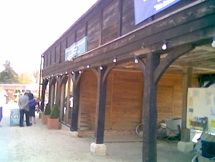
There have been many rebuilds. In Shakespeare’s time the Town Hall was built in stone, and in 1721 the Lords, Eversfield and Ingram, had it rebuilt in portland stone and gifted it to the people of Horsham.
Unfortunately the rebuilds proved to be of not such great quality, so in 1812 it was rebuilt by the then Duke of Norfolk. However, the roof let in so much rain, that the judges became convinced that the floor would give way under them. Then in 1888 came the final big building phase, which is what makes up the Town Hall as it stands today. The only part that dates from 1812 to survive the rebuilding of 1888 is the front.
The hall has been used for many different and varied purposes over hundreds of years; as a bank, concert venue, theatre, market, meetings, courts etc.
A Trust supporter recently found this entry in the Horsham Blue Book published 1939 showing how busy the Town Hall was in those days.
Town Hall; Sessions and Justices rooms, Headquarters Independent Order of Oddfellows, Ancient Order of Foresters, Freeman Hardy and Willis ltd.
Town Hall Chambers; National Provincial Bank Ltd, Inland Revenue Office, Customs Excise and Old Age Pensions Office, Hilton, Sharpe and Clark chartered and incorporated accountants

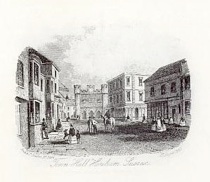
The barn at Waterperry gardens, above, is the kind of building that would have been familiar to Catherine Howard, the future Queen, when she lived at Chesworth in the 16th Century.
Drawing of the Town Hall, in about 1750 then built
in Portland Stone.
Drawing of the hall 27th August 1860
A vision of what is possible where buildings such as the Horsham Town Hall is concerned is set out in this extract from Francis Maude's weekly Francis' Footnote in an edition of the West Sussex County Times some years ago;
‘St Mary's in Springbourne is a deconsecrated church right in the heart of Bournemouth's most deprived area. It is a major community centre serving thousands of families that currently lacks basic facilities. And this is a community that needs facilities more than most. So over this week we've been working with the community to transform it into a self-sustaining centre; with space for local charities, an arts studio, a neighbourhood kitchen and a venue for conferences, exhibitions and drama productions. It's a project inspired by local people, volunteer-run and entrepreneurial. It’s taken a lot of work-painting, cleaning, and building. Even from me! On Tuesday I spent the whole morning painting and cleaning. I got so caught up in the job that I had to speak on the conference platform in painting clothes. There were loads of people helping-David Cameron and other Shadow Cabinet members, volunteers and even a journalist or two! Local MP, Tobias Elwood, organised the whole deal, and now his local community will be reaping rewards for years to come.’
This letter below from local artist John Bray appeared in the May edition of the Horsham Society Newsletter 2011. Mr Bray puts the Town Hall into context and underlines the reason why the supporters of the Blue Flash Music Trust feel that this iconic building has an enormous potential to offer not only the residents of Horsham but to people far beyond as well.

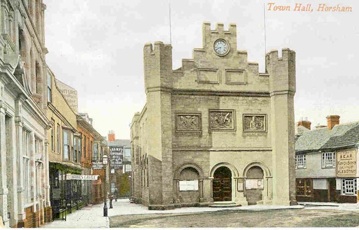
‘The Town Hall according to tradition was given to the town by the Eversfield family.’ W Albery (A Millennium of Facts).
In 1974 the hall lost its way as it was no longer considered necessary for the purposes of local government. Then in 2003 one of the members of the Trust realized it had great acoustics. With that realization the Trust obtained the first ever public entertainment licence on the building, which gave many people the chance to enjoy the acoustics.
Acoustics
Julian Lloyd Webber said he had been “delighted” to be Trust Patron in 2004 because he had played at the Town Hall in the 70’s and he liked the acoustics!
*
The Trust discovered (6 July 06) that Dr John Stoddart carried out an initial assessment of the acoustics of the Town Hall for the council (September 2005), which confirmed the suitability of the Town Hall for 'speech and chamber music.'
*
Gary Holder (double bass) has played in the Town Hall on a number of occasions;
‘The Horsham Town Hall has great acoustics and is ideal for live acoustic music or speech. Not another penny need be spent to improve on this. The beams I talked about are probably responsible for the quality of the sound. Normally in a large square area surrounded with high walls and ceilings you get a great deal of echo, but in the Horsham Town Hall what you have is a good quality, natural sound, which in my opinion puts the hall among the best venues in the whole town for live performance. I believe the blocks that run across the ceiling break up the reflection of the sound, blocking and redirecting it which stops the echo. No doubt the drapes at the tall windows also help. The main advantage of those great windows is the quality of light they provide. The venue has everything a great venue should have, good location, good facilities, top quality acoustics and good natural lighting by day. It's all there in a nut-shell.’
Tinted photo of the Horsham Town Hall taken about 1900
Below are the kinds of spaces the use of which has been denied to the community for a long time.
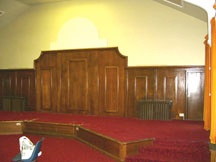


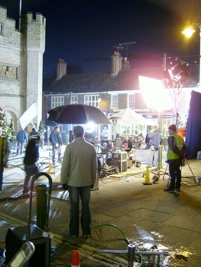

Historical interest; the original holding cells in the basement; six for women and six for men.
Dramatic potentials as this photo shows when the Christmas TV advert was made for Argos in 2005.
********************************************